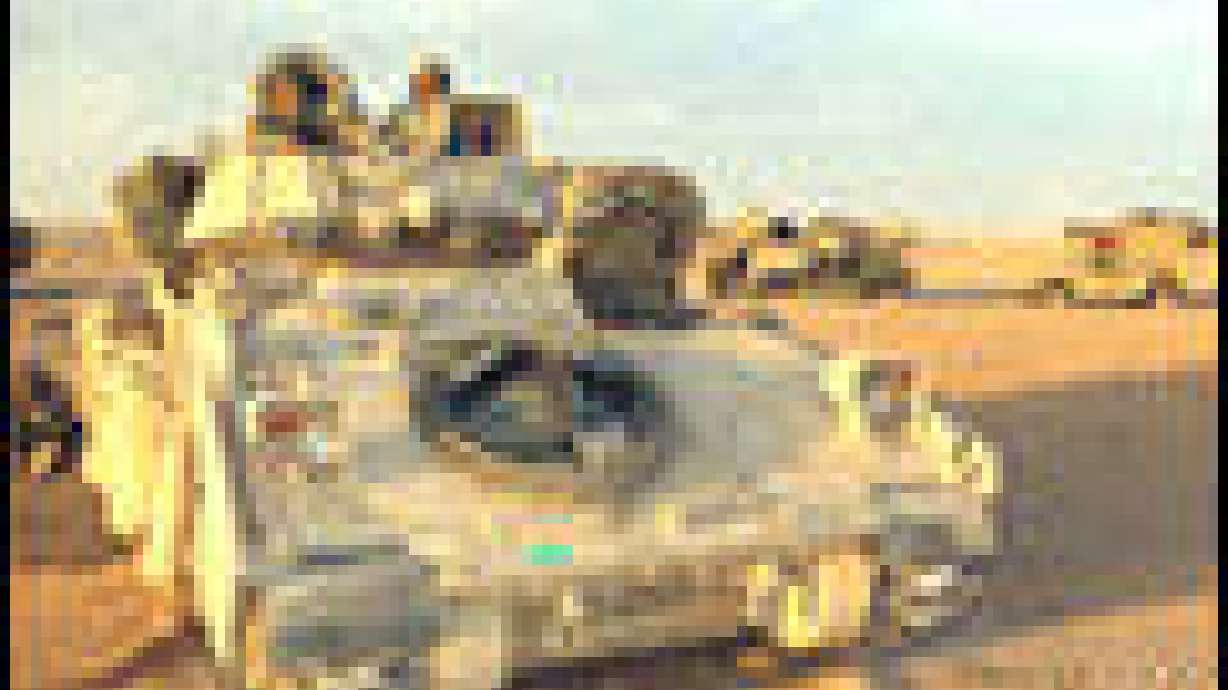Estimated read time: 3-4 minutes
This archived news story is available only for your personal, non-commercial use. Information in the story may be outdated or superseded by additional information. Reading or replaying the story in its archived form does not constitute a republication of the story.
CAMP AS SAYLIYAH, Qatar (AP) -- U.S. forces said Wednesday they are targeting Iraqi President Saddam Hussein's desert hometown, a redoubt bristling with loyalists who could be bent on making it the site of the regime's last stand.
U.S. Central Command said coalition airstrikes were targeting the Republican Guard's Adnan division in Tikrit, "shaping the battlefield" before American ground forces move in.
In nighttime raids in the last two days, U.S. Navy warplanes have bombed a Republican Guard barracks and garrison in the city 100 miles north of Baghdad, said Rear Adm. Barry Costello, commander of the USS Constellation.
Lt. Mark Kitchens, a Central Command spokesman, said special operations forces were "actively engaging" Iraqi forces there.
"We certainly are focused on Tikrit," said Brig. Gen. Vincent Brooks, at a Central Command briefing in Qatar, "to prevent the regime from being able to use it as a place to command and control, to restore command and control, or to hide."
Brooks said Iraqi reinforcements have moved to bolster Tikrit's defenses, with some coming up from the south as allied troops moved into Baghdad, and others coming down from the north, ahead of advancing coalition and Kurdish forces.
Brooks said he was "not going to predispose when will go in."
"There is still work to be done," he said.
Saddam, if he is still alive, may try to flee to his birthplace in the hope tribesmen with blood ties to him will fight to the death for their leader. Even if he is dead, experts fear Tikrit would remain a hotbed of resistance long after a new government is installed.
The town owes a lot to Saddam. Before his Baath Party came to power in 1968, it was a backwater. Thanks to government investment in infrastructure and business -- largesse straight from the man at the top -- Tikrit has grown into a sprawling town of 260,000 people.
Along with the garrison for the Republican Guard, Iraq's best-trained troops, Tikrit hosts an air base and air force academy.
Saddam has also studded the town with some of his largest and most elaborate presidential compounds. If he went into hiding there, regime watchers say he could easily vanish into the labyrinth of underground tunnels believed to link those sites to the eastern banks of the Tigris River.
The crash Monday near Tikrit of an American F-15E fighter jet was one sign of how the focus of the conflict is shifting to Tikrit. If shot down, it would be only the second coalition plane taken out by Iraqi fire.
Central Command said the cause of the incident was under investigation and rescue crews were searching Wednesday for the crew.
But the Patriotic Union of Kurdistan, one of two main Iraqi Kurdish groups opposing Saddam, claimed on Tuesday that Saddam already was hiding in Tikrit. The party's newspaper said Saddam, his two sons and many of his top aides moved there after fighting intensified in Baghdad.'
How much resistance Tikrit could muster is not clear. Tikrit is a power center for Sunni Arab tribes that may hold out for as long as possible out of fear of losing power to the nation's Shiite majority.
And if Saddam goes into hiding, he may be able to organize clandestine cells and launch a guerrilla war against U.S. troops similar to the one his Baath party waged in the 1950s.
"It is entirely possible that some residual elements of the Baath Party will reconstitute themselves as an underground revolutionary armed-struggle party that will launch terrorist attacks against U.S. forces and the interim authority," said John Pike, a military analyst at GlobalSecurity.org.
"Pacifying Tikrit is going to be a particular problem," he said.
In the Baath Party's early days, Saddam rose to prominence in 1959 by participating in a failed assassination attempt on then-Prime Minister Gen. Abdel-Karim Kassem.
Even back then, Tikrit served him well. After the botched assassination attempt, the young Saddam fled his hometown on horseback across the desert for neighboring Syria.
(Copyright 2003 by The Associated Press. All Rights Reserved.)









